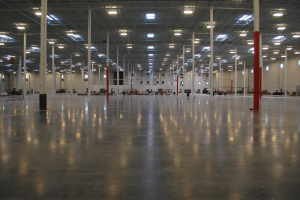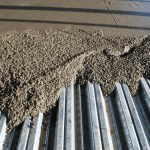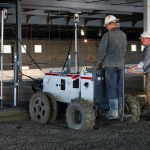Unwelcome Guests -Exposed Steel Fibers at the Floor Surface
Some people like steel fibers in their concrete floors, and some people don’t. Those who like steel fibers cite different reasons. One person is interested in wide-slab construction, using steel fibers to eliminate joints. Another favors steel fibers over wire mesh because it saves labor and makes the jobsite safer. A third relies on steel fibers to prevent curling in super flat floors.
In contrast, almost all the people who don’t like steel fibers have the same reason. They don’t want fibers sticking up and making their floors look bad.
How valid is their concern? As we shall see, fiber exposure is a real problem, but there are effective ways to prevent it.
Managing Expectations
Before getting into details, we have to recognize that some degree of fiber exposure must be expected on any floor that contains fibers. If a building owner has zero tolerance — I mean literally zero — for exposed fibers, then there is really just one answer. Don’t use fibers.
Fortunately, few owners take such an absolute position. Most will accept a few visible fibers or fiber fossils. (A fiber fossil is the imprint left after a surface fiber has come loose and vanished.) Look at Figures 1 and 2, which come from the same floor containing 1-inch, Type II fibers at 70 pcy. Figure 1 presents a normal view, with nary a fiber in sight. This is what a visitor would see on entering the building. Figure 2 presents a closer view of a small area with three fiber fossils. This is what someone searching hard for fibers could find. It’s a rare owner who won’t accept results like these. (Figure 2 also shows some scratches, which have nothing to do with the fibers.)
Figure 1. This warehouse floor is reinforced with 1-inch, Type II steel fibers at 70 pcy. Just walking around on it, you would be hard pressed to spot a fiber.
Figure 2. Close-up of the floor from Figure 1. If you look hard enough, you can find a few spots like this one. But only a few.
Of course, if you go around telling owners to expect a few visible fibers you have to be ready for the next question: How many? One way to answer that is to cite a Belgian standard, TV 204.1 See Tables 1 and 2 (below). According to the Belgians, a good result for a plain floor (no dry shake) is under six visible fibers per square metre of floor surface. Besides specifying limits, TV 204 spells out how fibers are to be counted. You don’t just look at one square metre in the worst part of the floor. You have to follow these steps:
Lay out several squares, each 10 metres by 10 metres, on the floor surface. If the floor area is under 10,000 square metres, lay out five such squares. But if the floor area is 10,0000 square metres or more, lay out ten squares.
Within each square, lay out five smaller squares, each 1 metre by 1 metre, chosen at random. Depending on the overall floor size, you will end up with 25 or 50 small squares.
Count the visible fibers in each small square.
Average the results of step 3 and compare with Table 1.
Though the Belgian standard can be a useful guide and may help resolve disputes, we should regard the numbers in it not as typical, but rather as the outer limits of what to expect. With the right fibers and attention to a few other details, floor contractors regularly achieve much better results.
Mistaken Identity
Often, when someone tells of fibers that bristled like corn stubble in a farmer’s field, the fibers turn out to be made of plastic, not steel. This is not to say plastic fibers always or even usually stick up. But sometimes they do, and they can do so in numbers that steel fibers never match.
Look at Figures 3 and 4 (below). Both come from a slab that included macrosynthetic fibers, made of polypropylene, at a dosage of 7.5 pcy. The area was finished by hand-trowelling, which undoubtedly added to the problem. But with or without hand-trowelling, steel fibers just don’t behave like this.
Figure 3. Exposed macrosynthetic fibers. Often when people complain of fiber sticking up, they are talking about macrosynthetics, not steel fibers.
Figure 4. More exposed macrosynthetic fibers. Steel fibers never stick up like this on a finished floor. They just don’t.
Steel Fibers Are Not All Alike
Some steel fibers are more likely than others to show at the floor surface. The most important factor is length; longer fibers are harder to hide. Problems rarely occur with 1-inch fibers, but are common with fibers that are 2 inches long or longer. Fiber shape also matters, with hooked and wavy fibers causing more trouble than fibers that are straight or nearly straight.
The differences between fibers come to the forefront when people try to design concrete mixes for high residual strength. As I’ve said before, I have serious doubts about the usefulness of residual strength in floor design and I encourage engineers not to rely on it. Still, some do rely on it, and this can lead to problems with exposed fibers. It turns out that some of the fiber properties that increase residual strength — namely greater length and hooked ends — also increase the likelihood of visible fibers at the floor surface.
It’s Not Always the Fibers’ Fault
Choosing the right fiber is important, but it’s not the whole story. The concrete mix and the way it is finished also affect the number of fibers visible at the floor surface.
Generally, the easier a mix is to finish, the less likely it is to leave fibers exposed (Figure 5 below). Anything that makes concrete more finishable — higher slump, more cement, more sand, natural sand instead of manufactured — will tend to keep fibers hidden. But you can only go so far in that direction, because some of those things, when taken to the extreme, lead to low concrete strength and excessive drying shrinkage.
Another factor is how the concrete is struck off. It’s important to use a vibratory tool on the floor surface, and not just internal vibrators. Somero Laser Screeds do a good job (Figure 6). So do truss-type vibrating screeds and some hand-pulled tools such as Magic Screed (Figure 7). But hand-rodding with a plain, nonmotorized straightedge is asking for trouble.
Figure 5. (Above Left) When fibers are short and the concrete mix is highly workable and finishable, the fibers can be hard to spot. One of the finishers on this job questioned whether the fibers were even there. But they were, at a dosage of 25 pcy. Figure 6. (Middle) Striking off with a vibratory tool keeps fibers down. This is a lightweight version of the Somero Laser Screed, usable on elevated slab pours. Figure 7. (right) Another vibratory strike-off tool
Finishing methods vary in their effect on fiber exposure. Floating and trowelling generally help, or at least don’t hurt. But finishing steps that involve scraping can cause trouble. Use of a straightedge to remove high spots, common in superflat construction, can leave fibers visible. This doesn’t mean straightedges can’t be used successfully on concrete with steel fibers, but you need to take care, especially when using them late in the finishing process. Worse than straightedging is broom-finishing. Few floors get a broom finish, but many outdoor pavements do. When combining steel fibers with a broom finish, we should probably loosen our standards with regard to exposed fibers.
The Great Cover-Up
For those stuck with harsh fibers that won’t stay hidden, there’s an easy way out. Cover them up with a dry shake. In Europe, where long, hooked fibers are common, many people consider a dry shake an essential part of a steel-fiber-reinforced floor. That view is less common in North America, but even here dry shakes are often used. The Concrete Floor Contractors Association of Canada, in a guide for floor designers, suggests that “the application of a 3 kg/m3 dry shake surface hardener can aid in covering surface fibres from view.”¹
Dry shakes work. That is, they generally do a good job of covering the fibers. But they come at a high price, and the monetary cost is just the start of it. Dry shakes make floors less flat. Bill Phelan, in an old but still relevant article, says “FF45 appears to be the maximum flatness that a knowledgeable concrete floor contractor would agree to deliver on a floor that has a hardened surface”.² That’s a side effect many people could live with, but there is another that is far more serious: delamination. Despite the most careful workmanship, dry shakes often fail to bond to the underlying concrete. An unbonded shake soon breaks up under traffic (Figure 8), and that creates a problem worse than any number of exposed fibers.
Figure 8. Dry shake that delaminated. Not every dry shake fails like this, but many do, and the results are never pretty. Would you risk this for the sake of covering a few steel fibers?
Advocates claim a dry shake doesn’t just hide fibers; it also helps the floor resist wear. Indeed, people often use a dry shake for this purpose even where there are no fibers to cover. But this argument is suspect — a least as far as rock-based shakes are concerned. (Most dry shakes are rock-based, consisting of rock particles coated with cement. Metallic dry shakes also exist, but are less common and cost more.) Testing with a Chaplin abrasion tester shows that rock-based dry shakes do not improve wear resistance. They either have no significant effect or they make the floor worse — contrary to what every dry-shake manufacturer claims. Look at Figure 9, which shows the results of wear tests with and without dry shakes.
Figure 9. This graph shows the results of wear tests with a Chaplin machine. Eight surfaces were tested, each with and without a dry shake. A positive reading shows that the plain concrete surface was better than (that is, showed less wear than) the surface with the dry shake. A negative reading shows that the dry shake performed better than plain concrete. The first six test results all involve rock-based dry shakes, and all six show that the shakes reduced the floors’ resistance to wear. Only the last two test results — one with a dry shake made of straight cement, and the other with a metallic shake — reveal any benefit from the dry shakes. The dry shakes used to hide fibers are almost always rock-based, and cannot be expected to improve a floor’s resistance to wear.
Relying on dry shakes to hide fibers is a bad deal, and one nobody has to make. Dry shakes cost money, have unwanted side-effects, and don’t improve wear resistance (unless they are metallic).
While we can never promise to cover every single fiber, we can keep the number of exposed fibers down to low, acceptable levels. All it takes is the right fibers — short, with small or no deformations — along with a finishable concrete mix and a little care in striking off and finishing.
References
1. Belgian Building Research Institute, Technische Voorlichting 204: Cementgebonden Bedrijfsvloeren, 1997, Table 13, p. 27.
1. Concrete Floor Contractors Association of Canada, Specifier’s Guide to Interior Concrete Floors, 2014, p. 21.
2. Bill Phelan, “Floors that Pass the Test”, Concrete Construction, January 1989.











